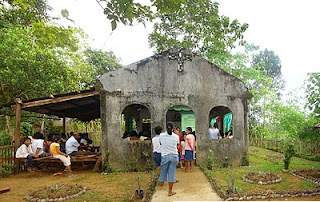Counting Numbers: Interpreting the SWS Survey on the State of the Roman Catholic Church in the Baleten-on Context
A storm in a tea cup. That's the impression of most of my priest-friends concerning the release of the 2003 SWS Survey about the present state of the Roman Catholic Church in the Philippines as the latter tries to come up with its so called Catholic Vote in time for the May 13, 2013 elections. The good Archbishop emeritus of Lingayen-Dagupan however sees it differently. But then that is his opinion.
In my interactions with the clergy, I have maintained that the 37% attendance during Sunday masses is almost realistic and questioned the basis in claiming the 64% turnout recorded in 1991. As we all know, the survey registered among others the following data:
The church of Balete has only two masses on Sunday and an anticipated mass on Saturday afternoon. A couple of mass is being said also in the chapels in Aranas and Feliciano during Sunday afternoon. Now, let us just divide 6,847 into 5 to have a better picture of the situation. That would give us 1,369 attendees for every mass being said at St. Rafael Parish Church and in the chapels of Aranas and Feliciano. Bear in mind that the figures include only the probable adult hearers. The church would really swell if we are to consider the minors. So we pause and consider these trends. Is this the real scenario? Are these figures reflective of the realities happening in the local church of Balete?
The last time I witnessed the church in Balete enjoyed sustained attendees was from the period 1993 to 2007. The apex of collections for monthly pledges alone reached to 60 Thousand Pesos plus sometime in 2007 and then suffered a dramatic decline afterwards prompting the current pastor to revert to the Arancel System. And yet in those days, a full packed church could only muster about a thousand souls. A lot of observers wondered why and the shepherds argued which patch of grass is greener for them to pasture their sheep. While they argued, 9.2% of the flock are straying off outside of the corral.
Yet we hope that with a dynamic Diocesan Pastoral Council (peopled by those with long experienced in community organizing), the arguing could be channeled to proactive formulation of a contextualized even if not common programs that are reflective of our Christian brotherhood in Christ Jesus.
 |
| The Roman Catholic chapel in Sitio Duduemon, Calizo, Balete |
In my interactions with the clergy, I have maintained that the 37% attendance during Sunday masses is almost realistic and questioned the basis in claiming the 64% turnout recorded in 1991. As we all know, the survey registered among others the following data:
- 81% of the Philippine Population are Roman Catholics
- 80% are of majority age (18 years old and above)
- 29% consider themselves very religious
- 37% go to church to hear mass at least once a week compared to the 64% in 1991
- 9.2% think seriously of leaving the Church
The church of Balete has only two masses on Sunday and an anticipated mass on Saturday afternoon. A couple of mass is being said also in the chapels in Aranas and Feliciano during Sunday afternoon. Now, let us just divide 6,847 into 5 to have a better picture of the situation. That would give us 1,369 attendees for every mass being said at St. Rafael Parish Church and in the chapels of Aranas and Feliciano. Bear in mind that the figures include only the probable adult hearers. The church would really swell if we are to consider the minors. So we pause and consider these trends. Is this the real scenario? Are these figures reflective of the realities happening in the local church of Balete?
The last time I witnessed the church in Balete enjoyed sustained attendees was from the period 1993 to 2007. The apex of collections for monthly pledges alone reached to 60 Thousand Pesos plus sometime in 2007 and then suffered a dramatic decline afterwards prompting the current pastor to revert to the Arancel System. And yet in those days, a full packed church could only muster about a thousand souls. A lot of observers wondered why and the shepherds argued which patch of grass is greener for them to pasture their sheep. While they argued, 9.2% of the flock are straying off outside of the corral.
Yet we hope that with a dynamic Diocesan Pastoral Council (peopled by those with long experienced in community organizing), the arguing could be channeled to proactive formulation of a contextualized even if not common programs that are reflective of our Christian brotherhood in Christ Jesus.


Comments
Post a Comment